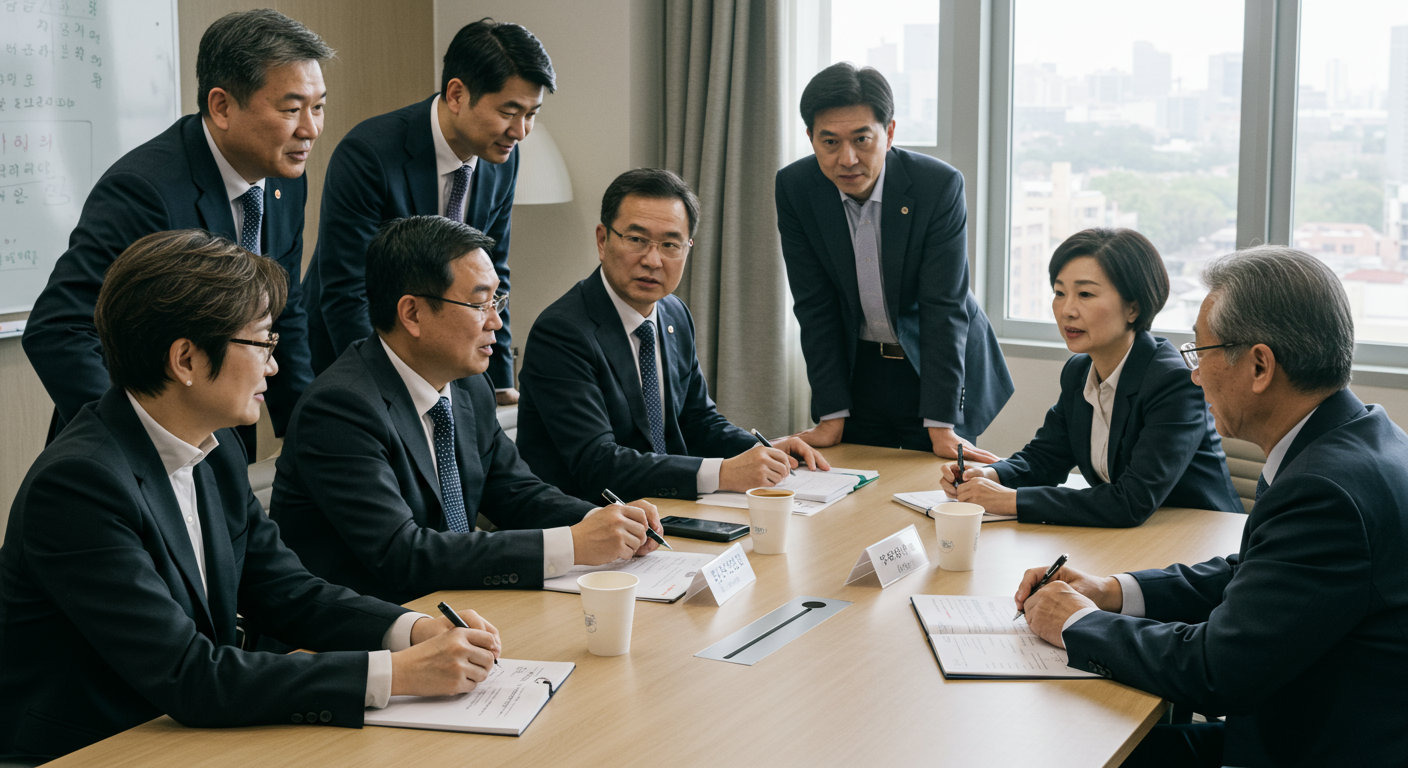Navigating Environmental Risk: A Deep Dive into Global Climate Policy
Navigating Environmental Risk: A Deep Dive into Global Climate Policy
Ever felt overwhelmed by the sheer scale of climate change, wondering how global decisions truly impact our everyday lives?
As a passionate student of global climate policy and environmental risk, I've spent countless hours trying to wrap my head around the complex interplay of science, economics, and politics. It’s a field that feels incredibly urgent, yet often baffling. Honestly, it was the pioneering research of Assistant Professor Yoo Jonghyun that really opened my eyes and pulled me deeper into this fascinating, albeit sometimes daunting, world. His work truly illuminated how critical it is for us to understand these challenges.
Table of Contents
The Intertwined Path: Climate Policy and Environmental Risk
When we talk about environmental risk, it’s not just about a melting glacier or a rising sea level anymore. It’s deeply, intricately linked to our global climate policy – or, let's be honest, sometimes the *lack* thereof. Think about it: a seemingly distant policy decision made in a negotiation room can ripple through global economies, influence food security, and even impact the stability of nations. That’s the "expensive problem" we’re facing right now. It directly affects businesses, communities, and our planet's very future.
For instance, I remember reading about the massive economic impact of extreme weather events in recent years. It’s not just the immediate damage, but the long-term disruption to supply chains, infrastructure, and even public health systems. We’re talking about billions of dollars in losses, often borne by the most vulnerable populations. The truth is, without robust and coherent climate policies, these risks will only compound, making future challenges far more daunting than they already are. It's a feedback loop, isn't it?
 Description: "A diverse group of international policy makers, a mix of men and women of various ages, earnestly discussing documents around a large, modern conference table. The room has large windows showcasing a cityscape under a slightly overcast sky, conveying a serious and collaborative atmosphere in a realistic photo style."
Description: "A diverse group of international policy makers, a mix of men and women of various ages, earnestly discussing documents around a large, modern conference table. The room has large windows showcasing a cityscape under a slightly overcast sky, conveying a serious and collaborative atmosphere in a realistic photo style."
Key Global Climate Policies and Frameworks
When we talk about global efforts, there are a few heavy hitters in the world of climate policy frameworks. These aren’t just abstract agreements; they’re the blueprints intended to guide nations towards sustainability and mitigate environmental catastrophe. It’s a bit like trying to coordinate a symphony with hundreds of instruments, all playing their own tune, but aiming for harmony. Here’s a quick overview of some pivotal ones:
| Policy/Framework | Primary Goal | Key Impact |
|---|---|---|
| Paris Agreement (2015) | Limit global warming to well below 2°C, preferably to 1.5°C. | First truly global, legally binding climate accord. Nationally Determined Contributions (NDCs). |
| IPCC Reports | Provide regular scientific assessments on climate change, its implications, and future risks. | Foundation for policy decisions, raising global awareness and urgency. |
| UNFCCC COPs | Annual conferences for global climate action negotiations. | Platform for international cooperation, setting new targets and implementing agreements. |
It’s easy to get bogged down in the acronyms, but what really matters is the underlying intent: to collaboratively reduce carbon emissions and protect our planet. My initial frustration was understanding how these grand policies trickled down to practical changes. That’s where the real challenge lies, isn't it?
 Description: "A young woman, a researcher in her late 20s, with focused expression, is analyzing complex climate data visualizations on multiple computer screens in a modern, brightly lit lab. Scientific charts and graphs are prominent, indicating data analysis and modeling. The image is in a realistic, slightly stylized photo look."
Description: "A young woman, a researcher in her late 20s, with focused expression, is analyzing complex climate data visualizations on multiple computer screens in a modern, brightly lit lab. Scientific charts and graphs are prominent, indicating data analysis and modeling. The image is in a realistic, slightly stylized photo look."
Assessing Environmental Risks: A Multi-Faceted Approach
Understanding environmental risk isn't a one-dimensional task. It requires a holistic perspective, recognizing various types of risks and how they might manifest. We often categorize these risks into physical, transition, and liability risks. For anyone looking to truly grasp the gravity of our situation, or even advise on sustainable development, it's vital to break them down. Here’s how we typically approach assessing them:
- Identify Physical Risks: This involves analyzing direct impacts of climate change like extreme weather, sea-level rise, heatwaves, and water scarcity. It's about mapping vulnerabilities – which regions, industries, or populations are most exposed?
- Evaluate Transition Risks: These stem from the shift to a low-carbon economy. Think about new policies, technology advancements (like renewable energy adoption), and changing consumer preferences. Industries heavily reliant on fossil fuels face significant challenges here.
- Assess Liability Risks: This is where things get really tricky for businesses and governments. It involves potential legal action taken against those who have contributed to climate change or failed to mitigate its impacts. It's a growing area, trust me.
- Quantify and Model Impacts: Using data-driven decisions and advanced modeling tools, we try to put numbers to these risks. What's the potential economic loss? How many people could be displaced? This is where a lot of complex research, like Professor Yoo's, comes into play.
- Develop Response Strategies: Once risks are identified, the next step is planning. This includes adaptation measures (adjusting to impacts) and mitigation efforts (reducing emissions).
I remember one case study on a coastal city's vulnerability to sea-level rise – it wasn't just about building higher seawalls, but also about the loss of coastal ecosystems, property value depreciation, and potential population displacement. It’s never just one thing, you know?
 Description: "An illustration featuring a stylized globe surrounded by interconnected icons representing different environmental risks: a rising tide, a cracked earth, a smokestack emitting fumes, and a legal gavel. The color palette is modern, with shades of purple, blue, and green, suggesting a blend of global impact and policy. The overall mood is serious but hopeful."
Description: "An illustration featuring a stylized globe surrounded by interconnected icons representing different environmental risks: a rising tide, a cracked earth, a smokestack emitting fumes, and a legal gavel. The color palette is modern, with shades of purple, blue, and green, suggesting a blend of global impact and policy. The overall mood is serious but hopeful."
The Role of Research and Data in Climate Action
Honestly, without robust research and reliable data, climate policy would be flying blind. This is where the work of brilliant minds, like Assistant Professor Yoo Jonghyun, becomes truly indispensable. Their studies provide the evidence, the projections, and the nuanced understanding that policy makers desperately need to make informed decisions. It’s not just about crunching numbers; it's about translating complex scientific realities into actionable strategies.
I recall a presentation where Professor Yoo discussed the challenges of integrating diverse data sets for regional environmental impact assessments. It was incredibly detailed, showing how local vulnerabilities often get overlooked in global models. That’s the kind of meticulous, ground-up work that builds trust and provides real value. It’s what helps shift policies from broad strokes to precise interventions, really making a difference on the ground. It highlights the importance of connecting academic rigor with real-world applications. That, my friends, is key to our future.
Building Resilience: Strategies for a Sustainable Future
So, where do we go from here? It’s not just about preventing the worst, but about building stronger, more adaptable societies. This concept of resilience is crucial. It means we need to both reduce our negative impact (mitigation) and prepare for the changes that are already inevitable (adaptation). Think of it like this: you stop digging the hole (mitigation) and start building ladders to get out of it (adaptation). It’s a dual approach, and honestly, both are equally vital. No, really, they are!
Mitigation strategies focus on reducing greenhouse gas emissions. This includes transitioning to renewable energy sources, improving energy efficiency, and implementing carbon capture technologies. It's about fundamental shifts in how we produce and consume energy.
Adaptation strategies involve adjusting to actual or expected future climate. This means developing early warning systems for extreme weather, building climate-resilient infrastructure, fostering drought-resistant agriculture, and protecting natural ecosystems that act as buffers.
What excites me most are the innovative solutions emerging from different sectors. From smart city planning that minimizes urban heat islands to advanced agricultural practices that conserve water, every small step contributes to our collective sustainability goals. It's not just about governments, it's about communities and individuals making conscious choices, too. And this is where policy truly hits the ground.
 Description: "A futuristic, sustainable cityscape at sunset, with buildings featuring vertical gardens and solar panels. Electric vehicles move silently on the streets, and people are walking or cycling. The atmosphere is calm and hopeful, depicted in a vibrant, slightly ethereal digital art style, emphasizing innovation and eco-friendly living."
Description: "A futuristic, sustainable cityscape at sunset, with buildings featuring vertical gardens and solar panels. Electric vehicles move silently on the streets, and people are walking or cycling. The atmosphere is calm and hopeful, depicted in a vibrant, slightly ethereal digital art style, emphasizing innovation and eco-friendly living."
The Road Ahead: Our Collective Climate Future
The journey to a truly sustainable future, free from the most severe environmental risks, is long and challenging. There's no magic bullet, no single policy that will fix everything overnight. But what I've learned, particularly through engaging with research like Professor Yoo's, is the undeniable power of informed, collaborative climate action. It's about continuous learning, adapting, and most importantly, acting.
So, what can we do? Stay informed. Support research. Advocate for robust global climate policy. Because ultimately, the future of our planet isn't just in the hands of policymakers or scientists; it’s in all of ours. Each decision, big or small, contributes to the collective tapestry of our future. Let's make it a resilient one.
Frequently Asked Questions (FAQs)
It impacts us through carbon pricing, renewable energy incentives, and regulations on emissions, which can influence energy costs, product prices, and even job markets. For businesses, new policies can create both challenges (e.g., higher compliance costs) and opportunities (e.g., demand for green products).
These policies shape economic landscapes by encouraging sustainable practices. For example, tax breaks for solar panels can reduce household utility bills, while stricter environmental standards might push companies to innovate or adjust production methods, ultimately affecting what goods and services are available and at what cost. They also drive investment into new green technologies, creating new jobs and industries.
The biggest challenge is achieving consensus among diverse nations with varying economic development levels and national interests. It’s hard enough to get one country to agree, let alone 190+! Balancing economic growth with environmental protection is a constant struggle, often leading to slow or inadequate action.
Overcoming these hurdles requires strong international cooperation, equitable burden-sharing, and innovative financing mechanisms. It also means building domestic political will and educating the public on the long-term benefits of climate action, moving beyond short-term economic concerns. Transparency and accountability in reporting emissions and progress also play a crucial role in building trust and driving ambition.
Beyond everyday habits, individuals can engage by supporting businesses with strong sustainability commitments, advocating for stronger local and national climate policies, participating in environmental organizations, and educating themselves and others on the urgency of climate change. Even small changes in lifestyle, like reducing meat consumption or choosing public transport, add up when done collectively.
You can also vote for political leaders who prioritize climate action, invest in green technologies, and even consider career paths that contribute to environmental solutions. Supporting research institutions like the one Professor Yoo works with can also have a profound impact, as their findings directly inform policy and public understanding.
© 2024 Your Blog Name. All Rights Reserved.
Comments
Post a Comment